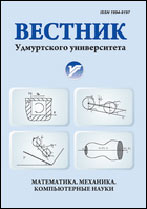|
|
Vestnik Udmurtskogo Universiteta. Matematika. Mekhanika. Komp'yuternye Nauki, 2014, Issue 1, Pages 19–31
(Mi vuu413)
|
 |
|
 |
This article is cited in 2 scientific papers (total in 2 papers)
MATHEMATICS
To the property of consistency for four-dimensional discrete-time linear stationary control systems with incomplete feedback of the special form
V. A. Zaitseva, N. V. Maksimovab
a Department of Differential Equations, Udmurt State University, ul. Universitetskaya, 1, Izhevsk, 426034, Russia
b Udmurt State University, ul. Universitetskaya, 1, Izhevsk, 426034, Russia
Abstract:
We consider a discrete-time linear control system with an incomplete feedback
$$
x(t+1)=A(t)x(t)+B(t)u(t),\quad y(t)=C^*(t)x(t),\quad u(t)=U(t)y(t),\quad t\in\mathbb Z.
$$
We study the problem of control over the asymptotic behavior of the closed-loop system
\begin{equation}
x(t+1)=(A(t)+B(t)U(t)C^*(t))x(t),\quad x\in\mathbb K^n,
\tag{1}
\end{equation}
where $\mathbb K=\mathbb C$ or $\mathbb K=\mathbb R$. For the above system, we introduce the concept of consistency, which is a generalization of the concept of complete controllability onto systems with an incomplete feedback. The focus is on the consistency property of the system (1). We have obtained new necessary conditions and sufficient conditions for the consistency of the above system including the case when the system is time-invariant. For the time-invariant system (1), we study the problem of arbitrary placement of eigenvalue spectrum. The objective is to reduce a characteristic polynomial of a matrix of the stationary system (1) to any prescribed polynomial by means of the time-invariant control $U$. For the system (1) with constant coefficients of the special form where the matrix $A$ is Hessenberg, the rows of the matrix $B$ before the $p$-th and the rows of the matrix $C$ after the $p$-th are equal to zero (not including $p$), the property of consistency is the sufficient condition for arbitrary placement of eigenvalue spectrum. It has been proved that the converse proposition is true for $n<4$ and false for $n>5$. In present paper we prove that the converse proposition is true for $n=4$.
Keywords:
linear control system, incomplete feedback, consistency, eigenvalue assignment, stabilization, discrete-time system.
Received: 22.12.2013
Citation:
V. A. Zaitsev, N. V. Maksimova, “To the property of consistency for four-dimensional discrete-time linear stationary control systems with incomplete feedback of the special form”, Vestn. Udmurtsk. Univ. Mat. Mekh. Komp. Nauki, 2014, no. 1, 19–31
Linking options:
https://www.mathnet.ru/eng/vuu413 https://www.mathnet.ru/eng/vuu/y2014/i1/p19
|

| Statistics & downloads: |
| Abstract page: | 368 | | Full-text PDF : | 171 | | References: | 91 |
|




 Contact us:
Contact us: Terms of Use
Terms of Use
 Registration to the website
Registration to the website Logotypes
Logotypes








 Citation in format
Citation in format 
